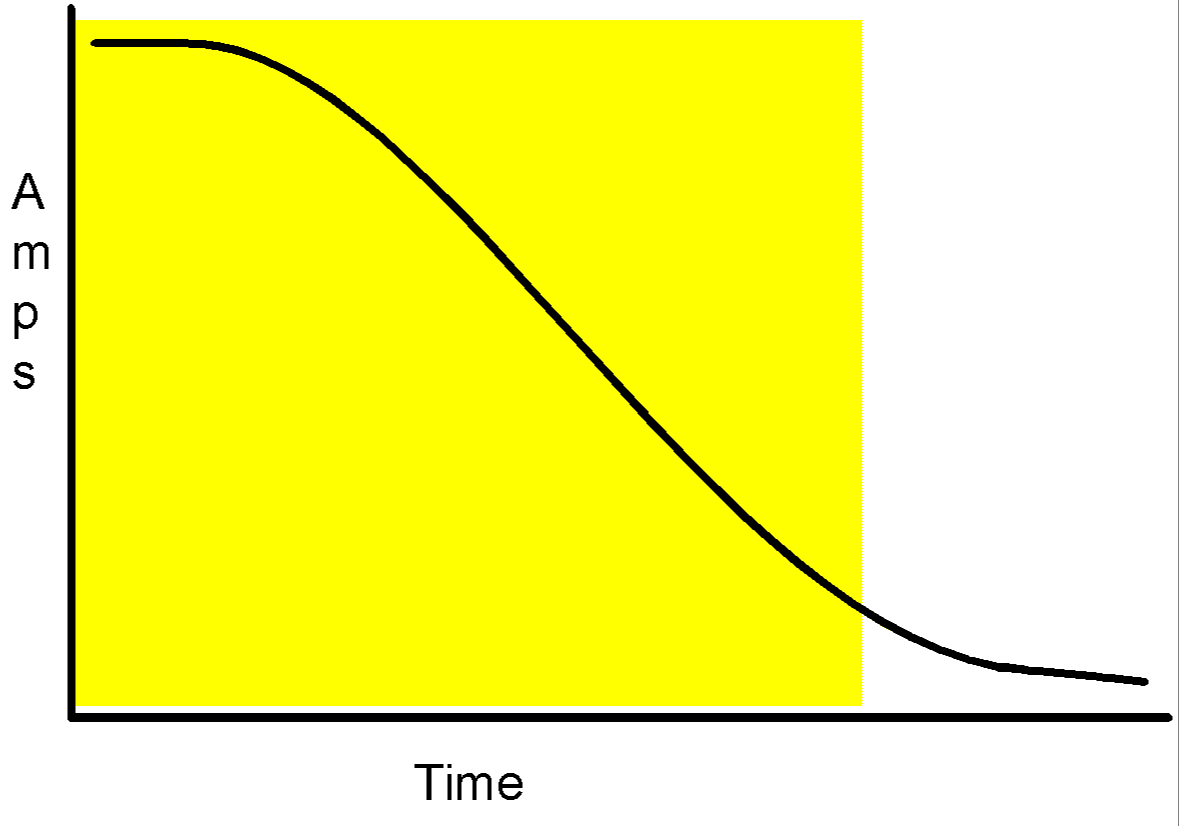 This
tail of float charge is of an unknown length.
This
tail of float charge is of an unknown length.ENERGY AUDIT
This gives you some idea of how many batteries you need to install.
For 12 volt loads divide their wattage by 12
For inverter driven loads divide their wattage by 10
This gives the number of amps drawn.
|
Item |
Current |
Hours used |
Amphours |
|
TV |
4 |
2 |
8 |
|
Lamp |
3.4 |
2 |
6.8 |
|
Fridge* |
0.8 |
24 |
19 |
|
Pump |
5 |
2 |
10 |
|
Lights |
6 x 1.8 |
4 |
43.2 |
|
Radio |
(say) 1 |
4 |
4 |
|
TOTAL |
91 |
||
|
With more usual fridge rating |
114 |
||
* This seems very low. Usually about 3.5 amps and running for 50% of the time = 42 Ah
The pump running time includes an allowance for shower pumps etc.
We must therefore provide and store at least 91 amp-hours of USABLE battery capacity.
We build a little safety margin in by ignoring the fact for some time in the day the alternator is supplying the fridge and water pump.
If you plan to spend a day without running your engine you must increase the hours to reflect this – thus for 1 day without charging we would need 182 Ah capacity.
BATTERY CAPACITY
You should only discharge your battery bank to about 50% of fully charged because to do more on a regular basis is likely to result in a dramatically shortened life.
The "normal" alternator regulator will only charge your batteries to something like 80% of fully charged – however large the alternator is!
So 80% - 50% = 30%
Our 91 amp-hours represents just 30% of the rated battery capacity, so we actually need: -
91 ¸ 30 X 100 = 303 amp-hours worth of batteries.
Thus 3 X 110 ah batteries should do.
For the higher fridge consumption needs 380 Ah
so 4 x 110 Ah batteries should suffice.
ALTERNATOR OUTPUT
The output of an alternator (amps) on a base of time is shown below:
 This
tail of float charge is of an unknown length.
This
tail of float charge is of an unknown length.
At first sight the unknown length of float charge makes it impossible to relate the alternators quoted (maximum) output to average output, but consider just the shaded portion.
An ammeter is required to be sure about the time represented by the shaded portion for any individual boat, but it will often be in the 2 to 3 hour range.
Over that 2 to 3 hours the alternator output will be about 50% of the rated output. So a 55 amp alternator delivers:-
55 ¸ 2 = 27.5 Amps average.
CHARGING BATTERIES
This depends upon battery condition, charge rate, temperature and probably what you are being sold.
I will assume 30% is realistic. This means that the 59Ah discharge will require about:-
91 ¸ 100 x 130 = 119 Ah of charge
(149 Ah - fridge)
The individual boater must make a decision, based on their use of the boat, about the balance between fast battery charging and long battery life.
I will be happy with a long-term charge rate of 20% of battery capacity and for short periods 30%.
CHARGING TIME
I need to supply 119Ah of charge at an average rate of 27.5 amps so:-
119 ¸ 27.5 = 4.33 hours
(149 ¸ 27.5 = 5.4 hours)
I know I must run for at least 4.33 hours a day to recharge my batteries - unfortunately the IWA only allows 3 hours running at their National Festival!
NOTE:- These long charge times may make the assumptions about average charge wrong. The average may well be lower than 50% of rated output.
Ways forward:-
Calculations using an 80 amp alternator:-
Recharge time:-
119 ¸ 40 = 2.9 hours
(149 ¸ 40 = 3.75 hours)
WILL THE CHARGE DAMAGE MY BATTERIES?
The alternator delivers about 65 amps for a few minutes as it warms up and then settles to its 55 amp output.
This is a split charge system with 3 x 110Ah domestic batteries and 1 x 90Ah starting battery giving a total capacity of 420Ah.
55 ¸ 420 x 100 = 13.4%
It is worth noting that the engine battery on twin alternator boats will be fully charged very quickly so unless you parallel both alternators you are wasting potential charge. This can be done with nothing more than a split charge relay joining the positives of both battery banks.
With 80 amp alternator:
80 ¸ 420 x 100 = 19.1%
SULPHATION
When a battery is left with any part of it not fully charged that part undergoes a chemical change and form a very persistent form of LEAD SULPHATE. When this happens that part can never be effectively recharged again.
With a "vehicle" alternator voltage regulator and typical engine running times you will have difficulty to charge it above 80% of fully charged. You will lose 20% of battery capacity this winter, 20% more next winter, and so on.
| Home | Index |